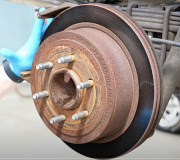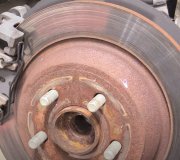This sounds like "make-work" when the dealer doesn't have a shop that's already busy. It is true, however, that every manufacturer does specify a time interval for replacing brake fluid, but few of us actually do that because the systems are so trouble-free.
I was disappointed to see Hyundai doesn't list the machining specs for their brake rotors. They only list the original sizes. I posted their chart below. Normally there are two additional specs we look at. One is called the "machine to" spec. As long as the rotor is still thicker than that spec, the rotor can be machined to true it up during the next standard brake service. If I recall correctly, that used to be.030" thinner than the original thickness. That was for older vehicles. Today rotors are so thin to save weight that they're often worn below that value from normal use, and they must be replaced. That machine to spec is a published legal limit the rotor can be machined to. No mechanic will risk his reputation or a lawsuit by machining a rotor thinner than that limit.
The second spec is called the "discard" spec. That was.015" thinner than the machine to spec. A rotor can not be machined to this thinner spec, but after machining, it can be allowed to wear to that thickness.
As for the fluid flush, there are some important points to be aware of. First, be careful to not allow any petroleum-based products to come in contact with brake fluid. Rubber seals in brake systems are not compatible with engine oil, transmission fluid, axle grease, power steering fluid, and penetrating oil. They will cause those parts to swell, and in the master cylinder, the rubber lip seals will become mushy and grow past the fluid return ports. That will trap brake fluid from freely flowing back into the reservoir. That will keep the brakes applied, often to the point of overheating and smoking. Professionals even wash their hands with soap and water before handling rubber brake parts to prevent contamination from fingerprint grease.
Next, there are a number of ways to remove the old fluid. I use simple gravity bleeding with a clear hose attached to the bleeder screw, and a little bucket for the fluid to flow into. That takes some time, but it's the easiest method. There are vacuum-operated hand pumps that will speed this up. With those, and with air-powered vacuum pumps, they'll suck air in past the threads of the bleeder screw. That air is nothing to worry about. The air will exit through the hose as a steady stream of very tiny bubbles. That's different from air being bled out after a repair to the hydraulic system. Those bubbles will be much bigger.
Some people prefer pedal-bleeding as it is one of the fastest methods, but in this case, it's important to never push the brake pedal more than halfway to the floor. Crud and corrosion build up in the lower halves of the bores in the master cylinder where the pistons don't normally travel. Pushing the pedal to the floor runs the rubber lip seals over that crud and can rip them. That results in a slowly sinking brake pedal, and it commonly takes two or three days to show up. This doesn't apply to any master cylinder less than about a year old as that corrosion hasn't developed yet, but it's a good habit to never push any brake pedal too far.
Don't let the reservoir run empty. Doing so will pump air into the system, then that will have to be bled out. Check the fluid level in the reservoir before you start the procedure. When you're done, refill it to exactly the same level. Don't fill it to the "max" line. As brake linings wear, the pistons in the calipers gradually move out to keep them in adjustment. Brake fluid fills in behind the pistons, so the level is going to go down in the reservoir. During normal brake jobs, those pistons have to be manually retracted to make room for the new, thicker pads. Doing that pushes the brake fluid back up into the reservoir, then the level will be full again. If someone filled the reservoir previously, the system will be overfull and fluid will overflow and spill out, creating a mess. Brake fluid eats paint too, so wash off any spilled fluid with water right away.
Brake fluid starts out clear, then becomes darker over time from being hot. That is not a reason to replace it. Replacing is recommended because it loves to absorb moisture out of the air, including through the rubber flex hoses which are porous. That moisture promotes the formation of corrosion, and it lowers the fluid's boiling point from well over 400 degrees to 212 degrees. It's pretty easy for brakes to get hotter than 200 degrees. That heat migrates into the brake fluid where the water will boil and turn to a vapor. The resulting air bubbles cause one type of brake fade, in this case, a low and soft brake pedal.
Let me know how this goes or if you have any questions.
Image (Click to make bigger)
Wednesday, September 25th, 2024 AT 4:02 PM





